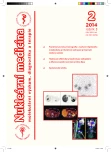Evaluation of the effectiveness of radioiodine ablation for differentiated thyroid carcinoma
Authors:
Vladimír Dedek 1; Martin Formánek 2,3; Petr Matoušek 2,3
Authors‘ workplace:
Klinika nukleární medicíny, Fakultní nemocnice Ostrava
1; Otorinolaryngologická klinika, Fakultní nemocnice Ostrava
2; Katedra kraniofaciálních oborů, Lékařská fakulta, Ostravská univerzita, Ostrava
3
Published in:
NuklMed 2014;3:31-36
Category:
Original Article
Overview
Introduction:
Initial therapeutic procedure for differentiated thyroid carcinoma (DTC) consists of the surgical treatment followed by radioiodine (RI) ablation of residual thyroid tissue.
Aim:
Evaluation of the success of the radioiodine ablation of thyroid remnants in patients operated in the Otorhinolaryngological (ORL) clinic of Faculty hospital Ostrava in the years 2007–2012.
Material:
131 patients with DTC after near-total thyroidectomy (nTTE), of which 109 patients with papillary (83 %) and 22 with follicular carcinoma (17 %). Distribution of patients according to the TNM classification: T1 72 pts, T2 21 pts, T3 5 pts and in the group of 33 pts tumor size was not detected (Tx).
Methods:
Hospitalization 5–6 weeks after nTTE in hypothyroidism, neck scintigraphy for visual assessment of residual thyroid tissue, administration of 3.7 GBq of 131I, rehospitalization after six months in myxedema, diagnostic whole-body scintigraphy after diagnostic dose of 110–185 MBq of radioiodine. The criterion for successful ablation of the thyroid remnants was a negative finding in the area of the thyroid bed. We also watched the success of RI ablation depending on the thyroglobulin level (Tg).
Results:
There was no residual thyroid tissue visible on the follow-up whole-body scintigrams in 105 of 131 patients (80 %). In the rest 26 cases (20 %), RI ablation was not successful and such pts required further RI therapy. The probability of successful RI ablation for Tg level <1 µg/l was 8:1, for Tg level between 1–10 µg/l 4,25:1 and for Tg >10 µg/l 0,75:1.
Conclusion:
We have demonstrated successful RI ablation after nTTE in 80 % of cases, which is comparable with the literature and suggests a satisfactory radical thyroid operation carried out in the ORL clinic in Faculty hospital in Ostrava. We consider the first thyroglobulin level an important factor in the prediction of successful RI thyroid remnant ablation. In cases with higher Tg level (usually above 10 µg/l) we prefer administration of therapeutic dose of 131I directly at repeated hospitalization.
Key Words:
differentiated thyroid cancer, radioiodine ablation, whole-body scintigraphy, thyroglobulin level
Sources
1. Sherman SI, Thyroid carcinoma. Lancet 2003;361:501–511
2. Davies L, Welch HG Increasing incidence of thyroid cancer in the United States, 1973-2002. JAMA 2006;295:2164–2167
3. Hasbek Z, Turgut B, Erselcan T et al. The evaluation of microcarcinoma in differentiated thyroid cancers according to old and new TNM classification. Molecul. Imag. and Radionuclide Therapy 2011;20:94–99
4. Publikace ÚZIS, Novotvary Česká republika, [online] [cit. 2014-05-15]. Dostupné na: http://www.uzis.cz/katalog/zdravotnicka-statistika/novotvary
5. Astl J. Chirurgická léčba nemocí štítné žlázy, 2. rozšířené vydání Praha, Maxdorf 2013, 254 p
6. Vlček P. Nádory štítné žlázy. Postgraduální medicína 2003;5:208-212
7. Moser E, Fristch S, Braun S. Thyroglobulin and I-131 uptake of remaining tissue in patients with differentiated carcinoma after thyroidectomy. Nucl Med Commun 1988;9:262–266
8. Fratkin MJ, Newsom HH, Sharp AR et al. Cervical distribution of iodine 131 following total thyroidectomy for thyroid cancer. Arch Surg. 1983;118:864–867
9. Vlček P. Radionuklidy v diagnostice a terapii tyreopatií. Postgraduální medicína 2003;5:212–215
10. Cooper DS, Doherty GM, Haugen BR et al. Revised American Thyroid Association Management Guidelines for Patients with Thyroid Nodules and Differentiated Thyroid Cancer The American Thyroid Association (ATA) Guidelines Taskforce on Thyroid Nodules and Differentiated Thyroid Cancer. Thyroid 2009;19:1167–1214
11. Klain M, Ricard M, Leboulleux S et al. Radioiodine therapy for papillary and follicular thyroid carcinoma. Eur J Nucl Med 2002;29(S 2):479–485
12. Mazzaferri EL, Jhiang SM. Differentiated thyroid cancer: longterm impact of initial therapy. Transactions of the American Clinical and Climatological Association 1994;106:151–168
13. DeGroot LJ, Kaplan EL, McCormick M et al. Natural history, treatment, and course of papillary thyroid carcinoma. J Clin Endocrinol Metab 1990;71:414–424
14. Chow SM, Law SC, Chan JK et al. Papillary microcarcinoma of the thyroid-Prognostic significance of lymph node metastasis and multifocality. Cancer 2003;98:31–40
15. Comtois R, Theriault C, Del Vecchio P. Assessment of the efficacy of iodine-131 for thyroid ablation. J Nucl Med 1993;34:1927–1930
16. Bal C, Padhy AK, Jana S et al. Prospective randomized clinical trial to evaluate the optimal dose of 131 I for remnant ablation in patients with differentiated thyroid carcinoma. Cancer 1996;77:2574–2580
17. Sengöz T, Sürücü E, Demir Y, Derebek E. The Effects of the Factors Related to the Patient and the Disease on the Performance of Ablation Therapy in Patients with Differentiated Thyroid Cancer who have Received I-131 Ablation Therapy. Mol Imaging Radionucl Ther 2012;21:103–109
18. Cherk MH, Kalff V, Yap KS et. al. Incidence of radiation thyroiditis and thyroid remnant ablation success rates following 1110 MBq (30 mCi) and 3700 MBq (100 mCi) post-surgical 131I ablation therapy for differentiated thyroid carcinoma. Clin Endocrinol 2008;69:957–962
19. Barbaro D, Boni G, Meucci G et al. Radioiodine treatment with 30 mCi after recombinant human thyrotropin stimulation in thyroid cancer: effectiveness for postsurgical remnants ablation and possible role of iodine content in L-thyroxine in the outcome of ablation. The Journal of Clinical Endocrinology & Metabolism 2003;88:4110–4115
20. Pacini F, Molinaro E, Castagna MG et al. Ablation of thyroid residues with 30 mCi (131)I: a comparison in thyroid cancer patients prepared with recombinant human TSH or thyroid hormone withdrawal. J Clin Endocrinol Metab 2002;87:4063–4068
21. Zidan J, Hefer E, Iosilevski G et al. Efficacy of I-131 ablation therapy using different doses as determined by postoperative thyroid scan uptake in patients with differentiated thyroid cancer. Int J Radiat Oncol Biol Phys 2004;59:1330–1336
Labels
Nuclear medicine Radiodiagnostics RadiotherapyArticle was published in
Nuclear Medicine

2014 Issue 2
Most read in this issue
- Evaluation of the effectiveness of radioiodine ablation for differentiated thyroid carcinoma
- Positron emission tomography with lipid metabolism markers for primary liver cancers imaging
